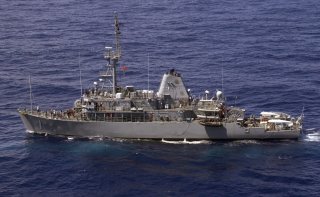Can the U.S. Navy Overcome Iran’s Naval Mine Might?
In the event of war with Iran, the U.S. Navy’s small, aging force of Persian Gulf-based minesweepers would struggle to locate and disarm Iran’s underwater mines.
Here's What You Need To Know: The Navy for years has diverted minesweeping funding into the development of multi-mission Littoral Combat Ships. The LCS were supposed to replace the Avengers, but the new ships have proved expensive, unreliable, and unsuitable for many of the missions the Navy hoped they would handle
In the event of war with Iran, the U.S. Navy’s small, aging force of Persian Gulf-based minesweepers would struggle to locate and disarm Iran’s underwater mines.
The consequences for U.S. military operations, not to mention world trade, could be severe.
Four of the Navy’s eleven 1980s-vintage Avenger-class minesweepers sail from Bahrain and, if war broke out, would be responsible for clearing the strategic Strait of Hormuz and other important waterways of mines.
But the Avengers suffer from obsolete equipment and a lack of spending. The minesweepers “routinely need repairs,” one Navy officer told Pro Publica reporters Robert Faturechi, Megan Rose, and T. Christian Miller.
The Navy for years has diverted minesweeping funding into the development of multi-mission Littoral Combat Ships. The LCS were supposed to replace the Avengers, but the new ships have proved expensive, unreliable, and unsuitable for many of the missions the Navy hoped they would handle.
The sailing branch in 2016 canceled development of a dedicated minehunting robot for the LCS. All the while, the Avengers slowly have rusted away.
“The companies that used to make a variety of spare parts no longer exist,” the reporters added. “A sailor recently aboard one ship said the sonar meant to detect mines was so imprecise that in training exercises it flagged dishwashers, crab traps and cars on the ocean floor as potential bombs.”
Minesweeper USS Devastator with the hull number MCM 6 was non-operational for so long that sailors jokingly referred to her as “Building 6,” since she never moved.
Senior Navy officials have called their mine warfare fleet in the Persian Gulf — a mix of aging ships, high-tech drones and helicopters — “the best and the brightest around,” and a Navy spokesman recently said the minesweeper fleet was “fully capable” of fulfilling its mission of finding and neutralizing mines. The Navy’s underwater drones, the spokesman said, “have a high rate of success,” and the sonar systems on the ships “are very accurate at detecting mines.”
While the spokesman conceded “there are challenges with all older ships, including maintenance and repair” that might make it take longer for the ships to accomplish their mission, he said maintenance problems have “dramatically improved” of late. He noted that as recently as July 6, [2019], all four of the older minesweepers based in the Persian Gulf had been at sea at the same time. (An officer aboard one of the ships called it a “photo exercise” and said it was “extraordinarily rare” to see all four out at once.)
War with Iran could require an intensive demining effort. The Islamic republic has the potential to drop thousands of mines in key waters. “Iran’s arsenal includes a mix of cheaper, older ones that float and blow up on impact, and more sophisticated ones that can be dropped from planes,” Faturechi, Miller and Rose wrote. “They sit on the ocean floor and explode after detecting nearby ships.”
“We certainly have the ability to do it,” Iran’s foreign minister, Mohammad Javad Zarif, said last month about closing the Strait of Hormuz, a critical commercial passageway. “But we certainly don’t want to do it because the Strait of Hormuz and the Persian Gulf are our lifeline.”
Sailors in the 5th Fleet’s minesweeping operations said they have watched the escalation of hostility in the Persian Gulf — the downing of drones by Iran and the U.S., masked gunmen rappelling from an Iranian helicopter to seize a British-flagged oil tanker — with a mix of excitement and pessimism. They are eager to contribute but doubt their ability to do so.
The Navy wants by 2020 to decommission three Avengers based in the United States in order to free up spare parts for the right minesweepers sailing from Bahrain and Japan. LCSs are still scheduled eventually to handle some minehunting missions, but the Navy also is experimenting with so-called “vessels of opportunity.”
Under that initiative, sailors embark on transport ships, amphibious auxiliaries, or other non-combat vessels and use them as bases for minehunting divers, underwater drones, and helicopters.
David Axe was Defense Editor of the National Interest. He is the author of the graphic novels War Fix, War Is Boring and Machete Squad.
This first appeared earlier and is being reposted due to reader interest.
Image: Wikipedia.

